Life After Death in the Deep Sea
By Richard Lutz, Timothy Shank, Robert Evans
Following immolation by volcanic eruption, the community around a hydrothermal vent recovers spectacularly
Following immolation by volcanic eruption, the community around a hydrothermal vent recovers spectacularly

DOI: 10.1511/2001.34.422
Some time between March 26 and April 4, 1991, on the crest of the East Pacific Rise between nine and ten degrees north of the equator, the ocean floor erupted.
By the morning of April 4, the research vessel Atlantis II and the deep submersible Alvin were above the site now known as Nine North to conduct the second part of a site survey for the Ocean Drilling Program. Scientists on board Atlantis II could not have known that 2,550 meters below their bunks, they would soon witness the very processes that drive this fast-spreading mid-ocean ridge and thus create ocean crust.
The eruption on the East Pacific Rise in the spring of 1991 gave geologists, geochemists and biologists a singular opportunity to study volcanic, hydrothermal and biological processes that accompany seafloor spreading. This article describes the original destruction and subsequent recovery of the vent communities in the years following the 1991 event at Nine North.
The eruption was not the first time that chance played a significant part in biological studies of the ocean floor. When hydrothermal venting from mid-ocean ridges was initially suggested and then confirmed in the late 1970s, no one expected to find rich communities of animals around the deep vents. But one of the great delights of research is surprise, and in 1977, surprised and delighted scientists found a self-contained yet diverse ecological system around vents along the Galápagos Rift, about a thousand kilometers southeast of Nine North. This chance discovery gave impetus to what would become entirely new areas of biological research, and our understanding of vent communities grew steadily throughout the '80s and '90s—accompanied by expressions of astonishment from biologists.
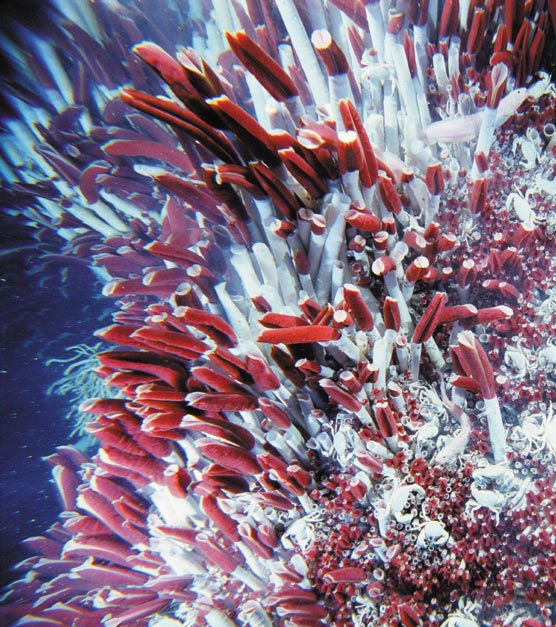
Photographs courtesy of Woods Hole Oceanographic Institution, Stephen Low Productions and Richard A. Lutz.
The communities around hydrothermal vents function without light and in an environment adjacent to water that would seem to be too hot and toxic to support life. Yet life there is fecund. Tubeworms, clams, mussels, gastropods, octopods, fish, grazing polychaete worms, scavenging crabs and other crustaceans inhabit these sites. To date more than 500 new species, more than 150 new genera—including vestimentiferans, the tubeworms—have been described from vents throughout the world's oceans. This abundance of life depends entirely on geothermal energy captured by chemosynthetic microbes, which use this energy to synthesize organic compounds through various chemical reactions. (See "Hydrothermal Vent Communities of the Deep Sea," July–August 1992.) The microbial base of the food chain in vent communities provides the ultimate support for the entire population, including uniquely adapted invertebrates—tubeworms, clams, mussels and others—living symbiotically with the microbes.
Intense and apparently predictable volcanic activity is typical of the crests of mid-ocean ridges. The East Pacific Rise at Nine North marks the boundary of the Cocos and Pacific plates, and along the crest of the ridge lies a narrow, linear feature generally less than 200 meters wide—the axial summit trough—caused by tectonic movements and local collapse after intrusion and drainage of lava. In the late '80s, bathymetric records showed an inflated section of the ridge between 9°45'N and 9°55'N. Ken Macdonald of the University of California, Santa Barbara, and his group described the feature and concluded that the inflation represented intrusion of lava beneath the seafloor and predicted that this part of the East Pacific Rise was ripe for an eruption. The scientific world did not have to wait long for the prediction to be verified.
In November and December of 1989, 83 kilometers of the East Pacific Rise between 9°09'N and 9°54'N were surveyed using ARGO, a towed frame of steel pipe holding lights, cameras, sonar and computer software to transmit continuous black-and-white images to monitors aboard the towing vessel. The optical and acoustic survey, the first part of the site survey for the Ocean Drilling Program, was so detailed that investigators mapped individual volcanic and tectonic features, the axial summit caldera and dozens of hydrothermal vents surrounded by dense biological communities. They learned that the axial summit caldera is so narrow and shallow over parts of its length that it could not have been detected by the earlier bathymetric work. The data from ARGO set the stage for a visual examination of the ridge crest in April of 1991 by observers in the submersible Alvin.
On April 4th, during dive 2354, John Edmond of MIT, Rachel Haymon of the University of California, Santa Barbara, and Woods Hole Oceanographic Institution pilot Dudley Foster descended aboard Alvin into the axial summit trough between 9°47.3'N and 9°47.7'N. They knew from the ARGO images that in this area the trough is less than 50 meters wide, only 10 to 15 deep, but replete with active hydrothermal vents and animal communities. With the crew of Alvin capable of navigating to an accuracy of 5 to 8 meters, it was not going to be difficult to visit 15 such sites in a 350-meter stretch between 9°47.38'N and 9°47.57'N. Fate, however, intervened to queer their expectations.
Cruising along the ocean bottom, the observers quickly found that the seafloor panorama had changed. Going from vent to vent expecting to see the abundant sessile animals in the ARGO images, they saw nothing but a seafloor covered with gleaming black flows of obsidian, the glass that forms from lava chilled instantaneously. Curtain-like folds of obsidian were completely free of sediment, as though they had poured onto the seafloor the day before. The focused vents at the top of mineral chimneys seen in the 1989 images were gone, replaced by diffuse flows of cloudy water coming from holes and cracks in the glassy lava. Not one of the 15 biological communities had survived.
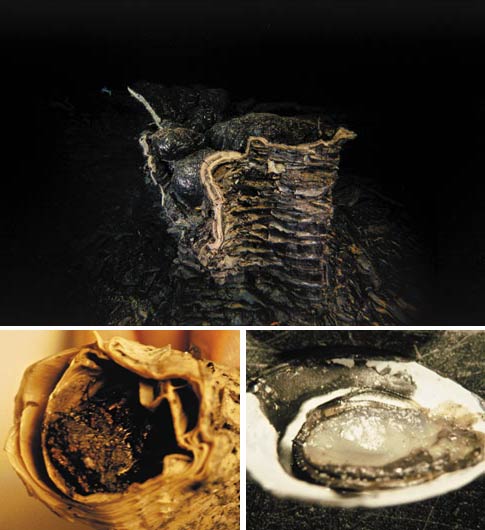
Photographs courtesy of Woods Hole Oceanographic Institution, Stephen Low Productions and Richard A. Lutz.
On April 14th, if further confirmation of the prediction of a few years earlier were needed, Haymon, Dudley and Karen von Damm of the University of New Hampshire made an extraordinary discovery aboard Alvin on dive 2363. On the eastern side of the axial summit caldera at 9°50.6'N, they found a populous vent community devastated by volcanic activity and partially overrun by lava. Littering the seafloor were dead and dying tubeworms, some enveloped in obsidian, others fragmented as though they had exploded. Shattered mussels were scattered everywhere. Tissue from a dead tubeworm was charred black, and the flesh of limpets attached to the tubeworm was seared and cooked, as though "steamed on the half-shell" (see Figure 2). The violence of the event had thrown fragments of dead tubeworms outside the axial summit trough, and its recency was evident from the absence of any scavengers on the abundant food provided by the dead. With the grim humor that makes any devastation easier to tolerate, the observers on board Atlantis II dubbed the site "Tubeworm Barbecue," a name that endures to this day.
Radiometric dating of the fresh lavas provided corroboration of their youth. The short-lived radionuclide polonium-210 degasses completely from newly erupted lava, but over a period of one or two years appears in the cooled basalt as a decay product of lead-210. After seafloor basalts were collected from Tubeworm Barbecue, regular measurement of their lead-210 during the next six months allowed researchers to calculate the date of their emergence: somewhere between March 26th and April 6th, 1991. It is worth remarking that the purpose of the site survey for the ocean drilling program was to aid in the selection of a drill site on oceanic crust of zero age. Serendipity had brought Atlantis II and Alvin to a place where lava was emerging on the seafloor at the very moment the ship and its submersible floated above it. For the purposes of ocean drilling, there could be no younger crust anywhere on Earth.
If one problem dominates thought about hydrothermal vent communities, it has to be the question of how the various organisms establish and maintain thriving populations at sites that are at once widely separated and ephemeral. What mechanisms have evolved to ensure settlement and survival at a vent field whose existence may be measured only in years, and which may be separated from other vents by tens and even hundreds of kilometers? The eruption of 1991 gave biologists a rare opportunity to examine the colonization of an environment rendered virtually barren by geologic processes. Nine North was a perfect site for the task.
The photosurvey completed by the deep-towed ARGO in November 1989 showed observers a particularly active hydrothermal vent-field between 9°49.61'N and 9°50.36'N, with well-developed faunal communities between 9°45'N and 9°51'N. After the eruption and the destruction of the 15 communities imaged by ARGO between 9°47.38'N and 9°47.57'N, all that was left of those sites were the outpourings of hot fluids from cracks and fissures in bare basalt, and more diffuse flows from deep pits of collapsed lava. The old vents had been buried by lava, and new ones devoid of megafauna were beginning to function. By March of 1992, some invertebrates typical of vent faunal assemblages had appeared around the diffuse flows, providing impetus to the original plans for a comprehensive study of how nature rebuilds after a disaster on the mid-ocean ridge.
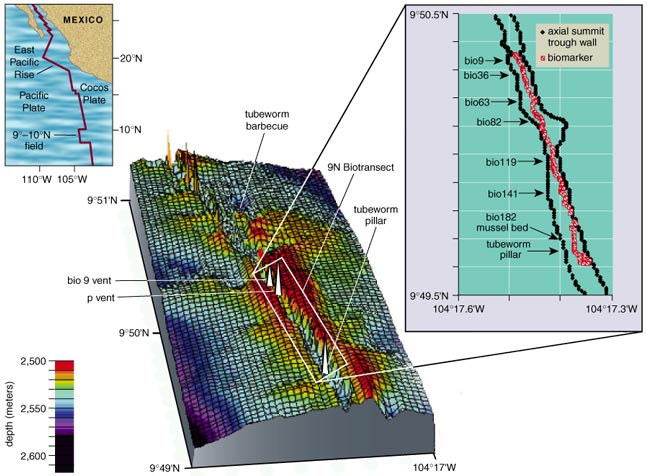
Tom Dunne
The plan, conducted in an area known as the 9N Biotransect (see Figure 3), was to describe—over a period of several years—the sequence of colonization by various species and to assess the rate at which colonization takes place. Measurements of fluid chemistry and temperature during that period would allow scientists to correlate environmental factors with faunal change and community structure. To the original ARGO images and data would be added information from the dives of April 1991 and from other visits during 1992 and each subsequent year through 2000. The diminutive but redoubtable Alvin would carry the observers for all those visits to a portion of the ridge crest some 1.37 kilometers long.
Crews in Alvin on dives 2496, 2499 and 2501 deployed 210 numbered and coded markers at intervals between 1 and 15 meters along the chosen transect. Geodetic surveys by acoustic ranging from Alvin established the position of the markers to within 2–4 meters and then tied them to global positioning system (GPS) data. Weighted by a 0.5 kilogram steel bar, the markers did not move from their original positions during the period of the research, except for a few that shifted as lava surfaces beneath them collapsed or as maneuvering of Alvin slightly altered their position.
Elaborate imaging surveys recorded the changes on the seafloor. In March 1992, crews took color video (using a single-chip video system) and 35-millimeter photographic images. From 1993 to 2000, they collected high-resolution (three-chip) video images illuminated by metal-halide lighting. This latter system, with a zoom lens with a focal length of between 5 and 47 millimeters, and a laser-scaling device to measure size and distance, allowed for quantitative measurements of the area occupied by organisms. Samples of vent fluids collected throughout the period of research recorded changes in concentration of many chemical species, including hydrogen sulfide, iron, carbon dioxide, methane, magnesium, chloride and silica. Scientists on Atlantis II and in Alvin measured the temperature of diffuse fluids during each field season and left self-recording, time-lapse temperature probes on the bottom to provide a continuous stream of data in the interim.
Even though the coverage of the imaging surveys was detailed and extensive, investigators knew that the problem in attempting to chronicle continuous changes on a remote seafloor site visited only intermittently was like the problem of trying to create a movie from an sequence of stills. But just as Ken Burns was able to use photographs and historical documents to create an impressive and popular "movie" chronicle of the Civil War in 1989, the periodic survey of Nine North worked to give us a narrative of growth of vent communities.
The original food source: In the first hours or days of the eruption, the megafaunal communities around dozens of vents were destroyed, but within days of that destruction, life returned. White microbial mats—unlike anything in the ARGO images—began to appear in cracks in the new ocean floor, around some of the new vents, on the walls of pits in the lava and around columns of fresh basalt. So great was the growth of microbial mats, and so powerful the flow of water escaping from new orifices, that clouds of white fragments up to 10 centimeters in size whirled upwards from the ocean floor to heights of 50 meters. It was a virtual "blizzard" of white particles, and it was not long before such vents became known as "snowblower vents" (see Figure 4).
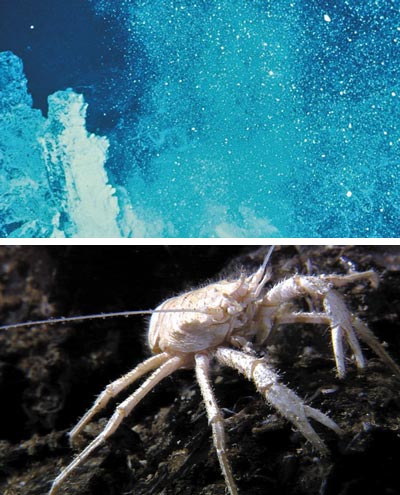
Photographs courtesy of Woods Hole Oceanographic Institution, Stephen Low Productions and Richard A. Lutz.
The proliferation of microbial mats, temporarily without predators, probably came from a latent population in the fractured and permeable lava through which seawater passes and heats up before surging upward back into the ocean. By the time that seawater has passed through the hot subsurface rocks, it contains the inorganic compounds—hydrogen sulfide and reduced species (for example, H2, Fe2+)—upon which chemosynthetic microbes depend. The subsurface biosphere, beneath land and the ocean, is more bountiful than was thought only a few years ago, with more than 250 strains having been isolated from deep-sea hydrothermal environments alone; here at the vents, the white microbial mats and flakes that formed "blizzards" consisted largely of sheath-like filaments rich in elemental sulfur. Its singular composition notwithstanding, such a vast supply of potential food would not long go unnoticed.
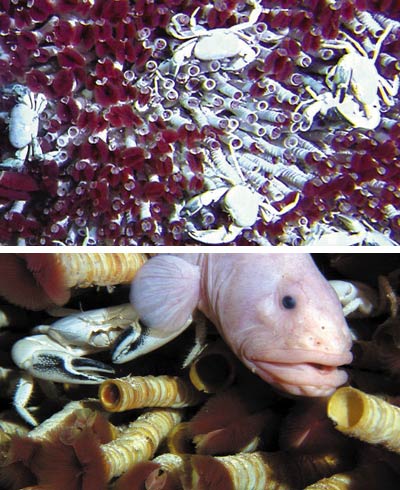
Photographs courtesy of Woods Hole Oceanographic Institution, Stephen Low Productions and Richard A. Lutz.
Invasion of grazers: Swimming or crawling, crustaceans came to take advantage of the bounty. Tiny copepods and clouds of small amphipods with 14 pairs of appendages grazed on organic matter attached to rock surfaces. Larger members of the crustacean order Decapoda also arrived: galatheid crabs (called squat lobsters) with a curled-under abdomen and a clear tail-fan (see Figure 4), and the more familiar brachyuran crabs (see Figure 5). Both animals are pure white, and when seen against the glassy black background of fresh lava look for all the world as though they are made of fine porcelain. Their stark appearance against the black background does them no disservice in this place where no natural light penetrates.
As the grazers fed on microbial mats, so other predators moved in to consume the grazers. Around the vents are two species of octopods, which presumably prey on crabs, bivalves and other invertebrates. A shrimp appeared, a species known also from non-vent environments, but here taking advantage of a beneficial opportunity in a place it would normally find hostile. Then came zooarcid fish, commonly known—and for obvious reasons—as eel-pouts (see Figure 5), an omnivore that feeds on a variety of organisms ranging from microbes to shrimp. All these mobile predators were early pioneers in a growing community soon to be dominated by tubeworms: sessile organisms characteristic of the East Pacific Rise. But unlike the grazers and predators, the tubeworms' dependence on bacteria is beneficial to the microbes.
Safety in symbiosis: Spectacular gardens of vestimentiferans around seafloor vents form indelible images in the minds of all who have seen them. They are the defining organism for mid-ocean ridge biology in this part of the oceans, and being sessile as adults presents no difficulties in adapting to the dramatically changeable environment along very active volcanic ridges. Tubeworms have mobile top-shaped larvae, which recruit or ingest the chemosynthetic bacteria that can tolerate and even thrive in the vent fluids. Thus equipped with both mobility and an internal source of energy, tubeworm larvae can survive until classic physico-chemical stimuli—perhaps temperature, microbial secretions or hydrogen sulfide—provide cues that they can settle in areas of diffuse hydrothermal flows in newly developing vent areas.
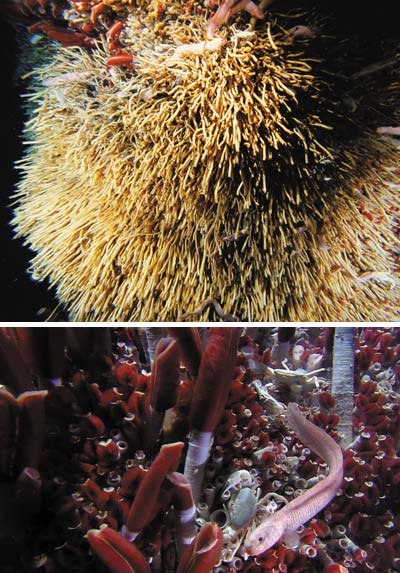
Photographs courtesy of Woods Hole Oceanographic Institution, Stephen Low Productions and Richard A. Lutz.
The smaller of the two principal tubeworms at Nine North, Tevnia jerichonana, settled first (see Figure 6). Within a year of the eruption, hundreds of individuals surrounded a vent, establishing the center of what is now recognized as a bull's-eye pattern of faunal distribution. A year later, however, as the levels of reduced chemical species in the hydrothermal fluids diminished, the larger tubeworm, Riftia pachyptila, perhaps less tolerant of the original toxicity, began to take over (see Figure 6). The growth of thousands of individuals of these large worms in sturdy tubes several feet long created more habitat for other organisms than did an accumulation of foot-long Tevnia, and so the arrival of Riftia presaged a change in the vent community.
The fruitful ground: If the health of a community is measured by the numbers and variety of its inhabitants, then the Riftia-dominated gardens around active vents are blooming and hale, providing some of the most spectacular scenery of the biotransect dives. Around the trunks of the large tubeworms are smaller clumps and clusters of Tevnia. Near the base of the cream-colored tubes, tufts of orange tentacles of individual polychaetes (bristle-worms, Paralvinalla grasslei) are easily seen, and tiny limpets mottle the tubeworm trunk. Like clouds of gnats in a garden on a summer day, swarms of amphipods hover above the beds of Riftia. These swarms may represent the greatest density of invertebrates known from the deep sea, with more than 1,000 individuals per liter.
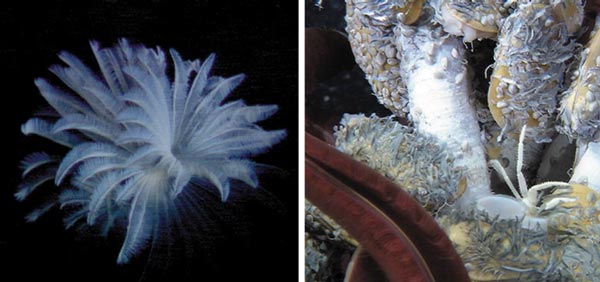
Photographs courtesy of Woods Hole Oceanographic Institution, Stephen Low Productions and Richard A. Lutz.
An occasional eel-pout, long and pink, winds its way among the tubes. Shrimp thrive, copepods hop about, and members of another crustacean order—leptostracans—appear among the 11 species recognized on video analyses. Limpets in gatherings of 100 to 500 individuals per square meter strip the bacterial mats from the neighboring seafloor. Brachyuran crabs maintain their station nearby. As we saw them through the observers' ports, resplendent in the lights of Alvin, the Riftia communities around hot effusions from the seafloor defied our very definition of what is toxic and uninhabitable. But much in nature is ephemeral, as the surveys of Nine North soon showed.
Fading of the fruitfulness: All life in vent colonies depends ultimately on the hydrothermal fluids that emanate from the seafloor, but the vagaries of that flow and the changes in its composition make possible rapid ecological changes in short spans of time. Despite the proliferation of biological activity at various sites at Nine North soon after the 1991 eruption, some of the new colonies were dead within less than three years. Hydrothermal flow waned at some sites, disappeared at others. With the source of nutrients diminishing, primary productivity declined—and with it all the organisms reliant on it.
Tevnia and Riftia disappeared from sites here and there, thriving only where the flow remained unchanged. As the flow elsewhere became focused to form pillars and columns of sulfides, predators grazed out of existence the extensive microbial mats in areas of diffuse flow. Life became concentrated at fewer and fewer sites, as only the mobile fauna could adapt to the sudden changes. Sessile organisms at outlying sites of previous diffuse flow died, creating patches of blight in areas of plenty.

Photographs courtesy of Woods Hole Oceanographic Institution, Stephen Low Productions and Richard A. Lutz.
Mytilids muscle in: Fifty-five months after the eruption and the start of new hydrothermal venting at Nine North, every vestimentiferan colony except one was surrounded by colonies of the mussel Bathymodiolus thermophilus (see Figure 8). Vulnerable to predation as larvae and as juveniles, and unable to thrive at high concentrations of hydrogen sulfide, the mussels kept their distance from the new and active vents. But as hydrogen sulfide levels in the vent water decreased, and as individuals grew to a size that gave them protection, they gradually encroached on the sessile organisms, eventually attaching themselves to the very tubes of Riftia and weighting them down to recumbency. Taking the vestimentiferan plume out of the water that contains the essential nutrients for its endosymbiotic bacteria decreases its chances of survival. And the mussels themselves utilize hydrogen sulfide that would otherwise be taken up by the tubeworms.
Bathymodiolus is a filter feeder on organic matter in the environment, but it also has a symbiotic relationship with vent bacteria, which in this otherwise toxic environment grant their host access to oxygen, carbon dioxide and reduced compounds of sulfur. Because they can function with or without the bacteria, the mussels become—in the language of biology—"facultative, not obligate endosymbiotic hosts." This flexibility in feeding grants mussels a survival advantage over other megafauna of hydrothermal vent fields, as we shall see.

Photographs courtesy of Woods Hole Oceanographic Institution, Stephen Low Productions and Richard A. Lutz.
The march of the scavengers to clean up the dead: It is not always a sudden eruptive disaster that destroys the communities around hydrothermal vents, nor even an abrupt ending of water flow from the oceanic crust. Observations made after the eruption of 1991 at Nine North show that a slow decrease in the amount of flow, and slow changes in the composition of the water emerging from the crust, caused concomitant changes and eventual depopulation of the sessile organisms. As hydrogen sulfide concentrations diminished, serpulid worms and galatheid crabs, which have limited tolerance for the dissolved gas, moved closer and closer until they thrived in dense mussel communities and even among worm tubes.
When the inevitable happens, and the vestimentiferan colony dies, scavengers—colonial siphonophores and the galatheid crabs—move in to graze on the dead assemblages. It is a demonstration of the principle that "Where all life dies – nature breeds," as John Milton noted in Paradise Lost, an apt title for what happens to the fecund communities around hydrothermal vents on the seafloor.
Good scientific work grants us the ability to make predictions, which are the ultimate measure of our understanding of any natural system. For example, the evolution of our ideas about the movement of continents—now collectively embraced in the framework of plate tectonics—was punctuated by predictions. One forecast the nature of motion along transform faults, another the age of islands in oceanic chains, yet others the age of salt beds in and around the North Atlantic margins and the age patterns of ocean crust. All those predictions were right, and today our understanding of geological processes that operate at mid-ocean ridges, and our appreciation of the effect that those processes have on biological activity, allow us to describe what will probably happen next within the axial summit trough of the ocean ridge at Nine North.
Geological activity therein will wax and wane, as it has for millions of years. Intermittent activity along fissures will release eruptions of oceanic basalt over short distances, destroying some existing faunal communities, producing a sequence of changes like those we described above. But what then? And what will happen to the sites we visited in Alvin over the course of these studies?
Eruptions come and go, and with them effusions of hydrothermal fluids. The longer the hydrothermal flows from the crust persist, the greater the likelihood that their intensity and temperature will decrease. As the volume and temperature diminish, the amount of dissolved hydrogen sulfide also dwindles. Riftia, the larger of the two vestimentiferans, outcompetes the smaller Tevnia, but both are eventually superseded by mussels and clams. As the supply of organic matter from the diminishing vent fauna declines, organisms that feed from material in suspension also decline and disappear, to be replaced in the community by carnivores. As the last effusive gasps of fluid escape from vents and crevices, all that can endure are mollusks, and of those the mussels will be the last survivors. Both clams and mussels can use nutriment from their symbiotic bacteria, but only the latter can also filter sustenance from their environment. Being facultative, not obligate, endosymbiotic hosts to microbes, the mussels have an advantage when the bacteria disappear, and as go the microbes, so go the clams. Eventually, however, with no supply of nutrients emerging from the crust, not even the filter-feeding mussels can exist, and hydrothermal vent life at a geologically quiescent site will be extinguished.
To observers who have looked through the small windows of Alvin and admired the beauty and richness of the faunal assemblages at vent sites, the idea of such fecund life being extinguished seems unlikely. Were it not for the obvious destruction in the eruption of 1991, the loss of such a community might even be as inconceivable as was its very existence 25 years ago. But even as we imagine the ultimate demise of all the macroscopic life at sites that have now been studied so well, we can bring to mind the geological longevity of life on the mid-ocean ridges and remind ourselves how well it has adapted to the conditions in this uncertain environment.
For even as the last mussel dies at any site along the ridge, the planktonic larvae of vestimentiferans, of molluscs and of other species float in the water above the exhausted vent sites, moving freely away from their parents, awaiting that moment when a chemical or physical signal from another vent-field impels them to settle and begin the process of metamorphosis into adults. The demise of one community—at Nine North—may presage or signal the start of another similar community tens or hundreds of kilometers away.
As poets say, death shall have no dominion, even in the hazardous geological environment of mid-ocean ridges. The Phoenix destroyed in the fire of a mid-ocean eruption gives rise to its offspring—a new vent community elsewhere along the ridge—to live and thrive again for one, ten, fifty, one hundred, or even the five-hundred-year lifespan of the mythical bird. There is life after death in the deep ocean.
We especially thank the master, officers and crew of the R/V Atlantis II and pilots of DSV Alvin for their invaluable technical expertise, assistance and patience throughout the course of numerous dive programs to the 9N Biotransect area; and W. Lange of the Woods Hole Oceanographic Institution for his technical expertise in providing an array of high-resolution and high-definition camera and recording systems crucial to the success of our studies.
Click "American Scientist" to access home page
American Scientist Comments and Discussion
To discuss our articles or comment on them, please share them and tag American Scientist on social media platforms. Here are links to our profiles on Twitter, Facebook, and LinkedIn.
If we re-share your post, we will moderate comments/discussion following our comments policy.